The hidden art of Mexico City
CDMX's art scene may be world renowned—but leave the museum and take a peek into the grungy basements and dark alleys to find the true expressions of this city.
If you’re anything like my friends, a trip to Mexico City isn’t complete without a healthy mix of art museums, fine dining, street tacos, and a churro (or six). Maybe you enjoy a mezcal flight or a taco bike tour. Or you hop a bus to Teotihuacan to see the pyramids. No matter what, you’re in for a cultural experience that transcends nearly 700 years of history.
Ciudad de México has been expressing itself through art since its settling in the 1300s. More recently, Mexico City has finally gained the recognition as one of the world’s most exciting art scenes. And rightfully so—Mexican artists celebrate their indigenous roots through modern textile patterns and glorify their revolution(s) through printmaking. Do yourself a favor one day and visit Museo Nacional de Arte, Museo Nacional de Antropología and Museo Nacional de la Estampa to experience your share of Rufino Tamayo, Dr. Atl, Sebastian Fund, Frida Kahlo, and Diego Rivera.
Then promptly walk outside and open your eyes to what today’s artists are creating.
Stickers and street art
I spent nearly a week in CDMX trying to catch Meghan at a half run from a full block behind. We’d wander Condesa, Roma Norte, and Centro every day in search of locally roasted coffee and Mexican produced wine when suddenly I’d be distracted by the back of a stop sign and lose Meghan by the next turn.
There. Are. Stickers. Everywhere.
And these things are incredible. They’re hand drawn and rough cut and lewd and political and overly detailed and unapologetically expressive of their creators’ beliefs.
They’re art in its purest form.
After the third day of having to wait on the wrong side of a traffic light for me to catch up, Meghan explained to a friend that I was behind again because I “probably found another sticker or something.” I couldn’t stop talking about them. And I took our friend’s response of, “Mac—I’m sorry—I’ve literally never thought about a sticker on the street before,” as a challenge to show her the world.
Some highlights include:
This bird. I wish I could find the artist behind it. Variations of it were all over the city. And if you look closely at the collage above, the style suggests that the same artist made the snail and cactus stickers as well.
What’s interesting to me is that this floral pattern that makes up some noticeable part of the animal is a distinctly coastal style of Mexican printmaking. I know it as belonging to Todos Santos and other parts of Baja. Weird that it’s so prominently all over CDMX.
Whatever the hell this is.
This print/poster was about two feet long and similarly was the exact same style as other large prints found around the city. It looks printed (as opposed to hand pulled), but every example I found was unique. Still, crazy subject matter and crazier detail.
And the glue was still dry :chefs_kiss:
This whole wall was distinctly multiple artists and not a prearranged mural. But it’s the first example I’ve shared that actually did stop the whole group.
Pseudo-Keith Haring skaters, the ever present skull motif, and a quote that translates to “Eat and drink, life is short.”
I mean, if that ain’t street art, I don’t know what is.
A stop at Lugar de Huida
Lugar de Huida (Place of Escape) is exactly what you want in a printmaker’s studio. It’s a small space nestled into a Hipódromo street corner that’s nearly overflowing with local artists’ linoleum block prints. You’ll find everything from classic sugar skull and parading skeleton motifs to modern twists on Aztec feline engravings.
My nerdy side took over when the shopkeeper started opening drawers of the flat file and tossing prints my way. What I had assumed was paper supply storage turned out to be an overwhelming collection of the most intricately carved pieces I had ever held.
And I’m not exaggerating.
That print in her hand is black ink on white paper with a field of white stars. I kept asking if that was truly the case and had to double check if there was a language barrier (which, like, my ignorant American ass didn’t realize that she spoke 6 languages) because black ink DOES NOT PRINT ON PAPER LIKE THAT. You’ll see it in the collection we bought later in this post. It’s hard to describe the detail in this thing.
Anyway, we bought a few pieces and I learned a new technique for cutting boards to size and shrink wrapping art on the spot with a heat gun. It was rad.
…and then we casually heard about an art show in a warehouse in Centro.
La Fina Estampa 2024
So we’re checking out at Lugar de Huida when the shopkeeper mentions that her boss is somewhere in Centro selling art at a pop up. Meghan goes searching and finds an Instagram post for La Fina Estampa’s Feria de Grafica. Suddenly, we have an address that doesn’t map correctly on Google Maps and only enough Spanish between the two of us to order tacos al pastor and pour over coffee.
This is exactly what I was hoping to find in CDMX.
Apparently Pizza del Perro Negro is what we were looking for—a former warehouse space converted into an open air, punk pizza restaurant complete with a skate bowl and fully tattooed service crew.
We waited in line outside for 15 minutes because no one spoke English and we didn’t know how else to get in before we realized that we could just walk through the restaurant to the art show in the attic.
When I say punk, I mean that I don’t really know how this place was standing.
But at the top floor, we were greeted by 33 independent printmaking artists in a space that felt like it was built 100 years ago specifically for this day.
I cannot express to you the wave of feelings that came over me.
Art shows are cool. You’ve probably been to one or two yourself. But Mexico has a way of celebrating art that Americans just can’t match. This was an area of town that hosts nearly 150 museums—yet in the back of a dilapidated warehouse-turned-restaurant, up a flight of stairs with no signage, down a graffiti covered hall without lighting there is a room of locals buying art that is so packed you can barely walk through it.
Oh and not speaking Spanish? That didn’t help us find our way there. But I quickly realized that what I shared with these printmakers in art form was translation enough to get us through the day.
One artist was motioning as if they were carving into a clay block. I showed pictures of my linoleum blocks to an overjoyed smile.
One artist was trying to explain a local werewolf story to us and I pulled up my jeans to how him my tattoo of a Rougarou (a sort of Louisiana werewolf). He laughed and called over some friends to see it.
One artist had pieces that looked familiar and when I showed her a print I had at home, we realized I already owned her work.
The art we purchased
My rule is: the art finds you. I don’t always plan to buy art, but you’re going to see these pieces once in your life and regret buying them if you don’t. So here’s the list Meghan and I went home with:
The fox and werewolf are from Yel Eztli. Their story was something about three brothers who live in different mountains and all make art. I think they’re only in person, at art shows and can’t be found online.
The skulls and stickers are from Kalako Kalavera. His work is available at Lugar de Huida.
The turtle is from Adriana Ríos, also available at Lugar de Huida.
The alligator is “El coro” from Eduardo Robledo, also available at Lugar de Huida.
The tote bag is handmade by a couple. The wife sews the bags and her husband prints onto them. They are Pupè.
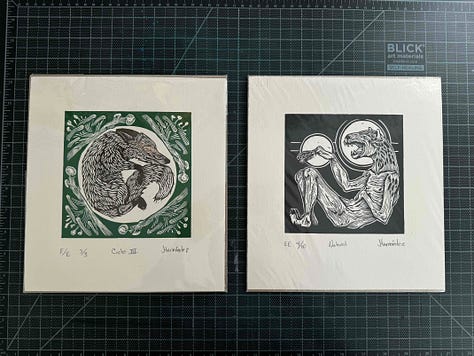

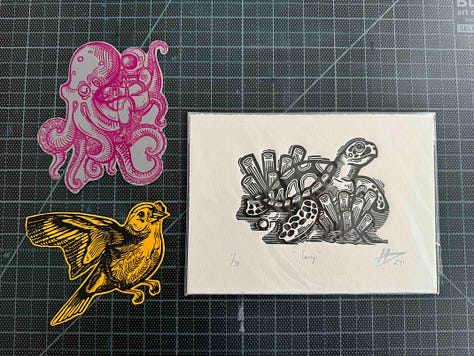

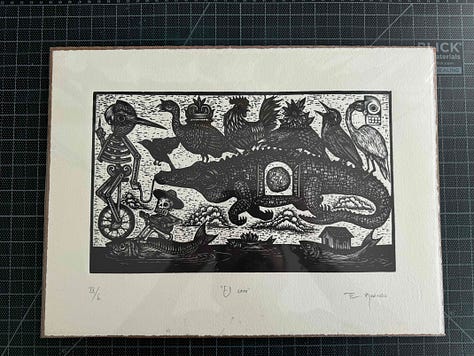

This is “Tzompantli” from Kalako Kalavera. It’s large and raw. You can almost feel the expression and physical movement of each carving stroke as you hold it.
You should check out his process video on Instagram and run down the rabbit hole of researching the tzompantli—a traditional Mesoamerican skull rack that displayed skulls of sacrificial victims.
This is “Me vuelvo cielo” from Gabriel Ávalos. This is the one I was raving about above. It’s black ink on white paper. The flower is a negative. Every star in the stem and every line in the flower has been carved out of the linoleum and still comes out with this much clarity when covered in ink. It blows my mind.
This is “Hijos de maiz y fuego” (Children of corn and fire) by Nahual Grafico.
I just… don’t even understand how this one works. I’ve been studying it constantly since picking it up. The lines of the river are relief cuts, meaning everything around those squiggly lines is cut away to raise them above the block. Those lines transition into negative cuts seamlessly, which is conceptually very hard to plan for before you start carving. And then the amount of detail once you get into the head and chest of the main figure is a hatching pattern that appears to be individual cuts (other artists would do this with a multi bladed tool that resembles a rake).
I’d pay to see the block that it took to pull this print. I can’t even guess how many carving hours it took to produce this.
If you made it this far, thanks for reading. Stick around for more stories and prints!
See you again soon 🏔️








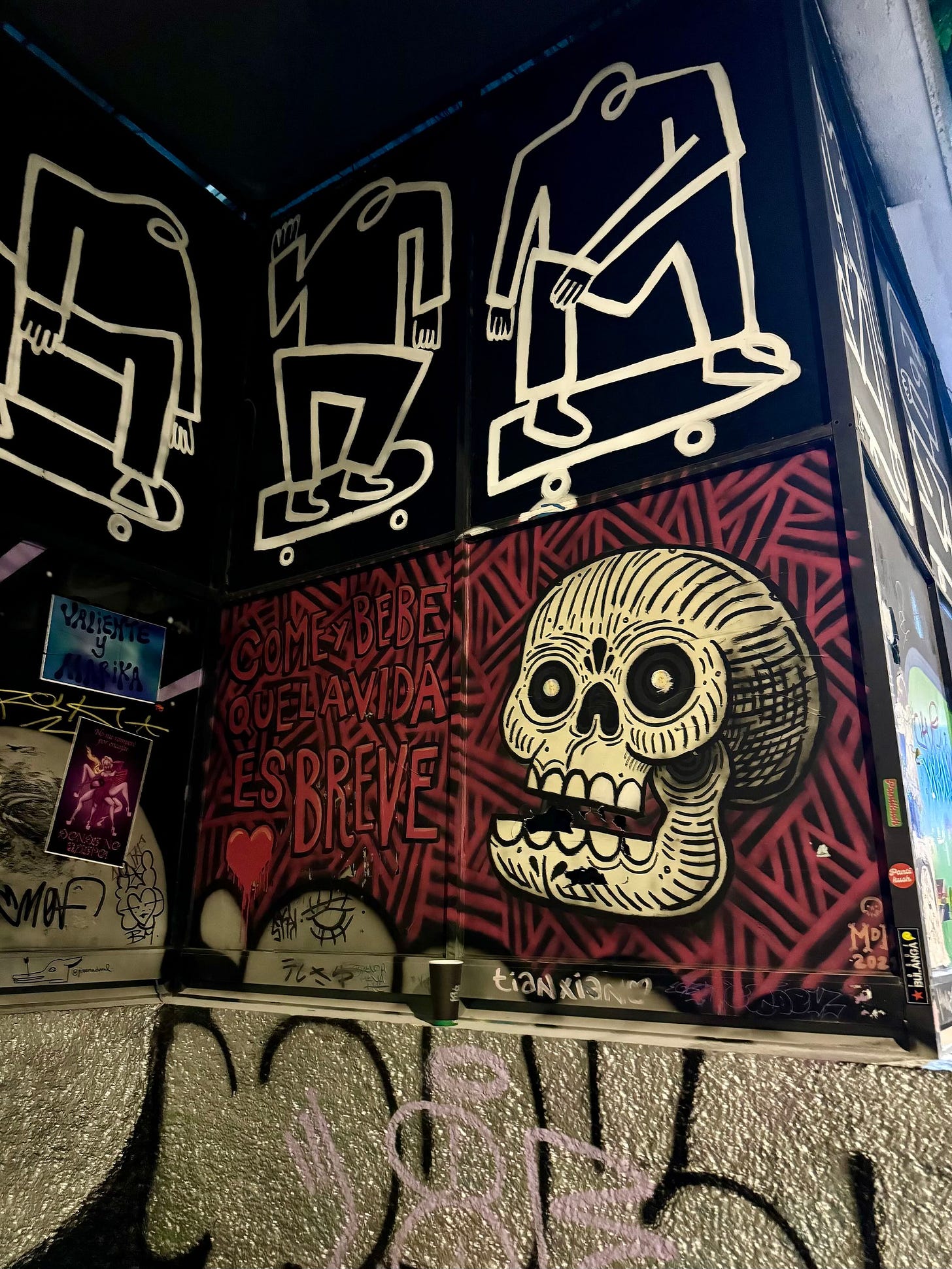




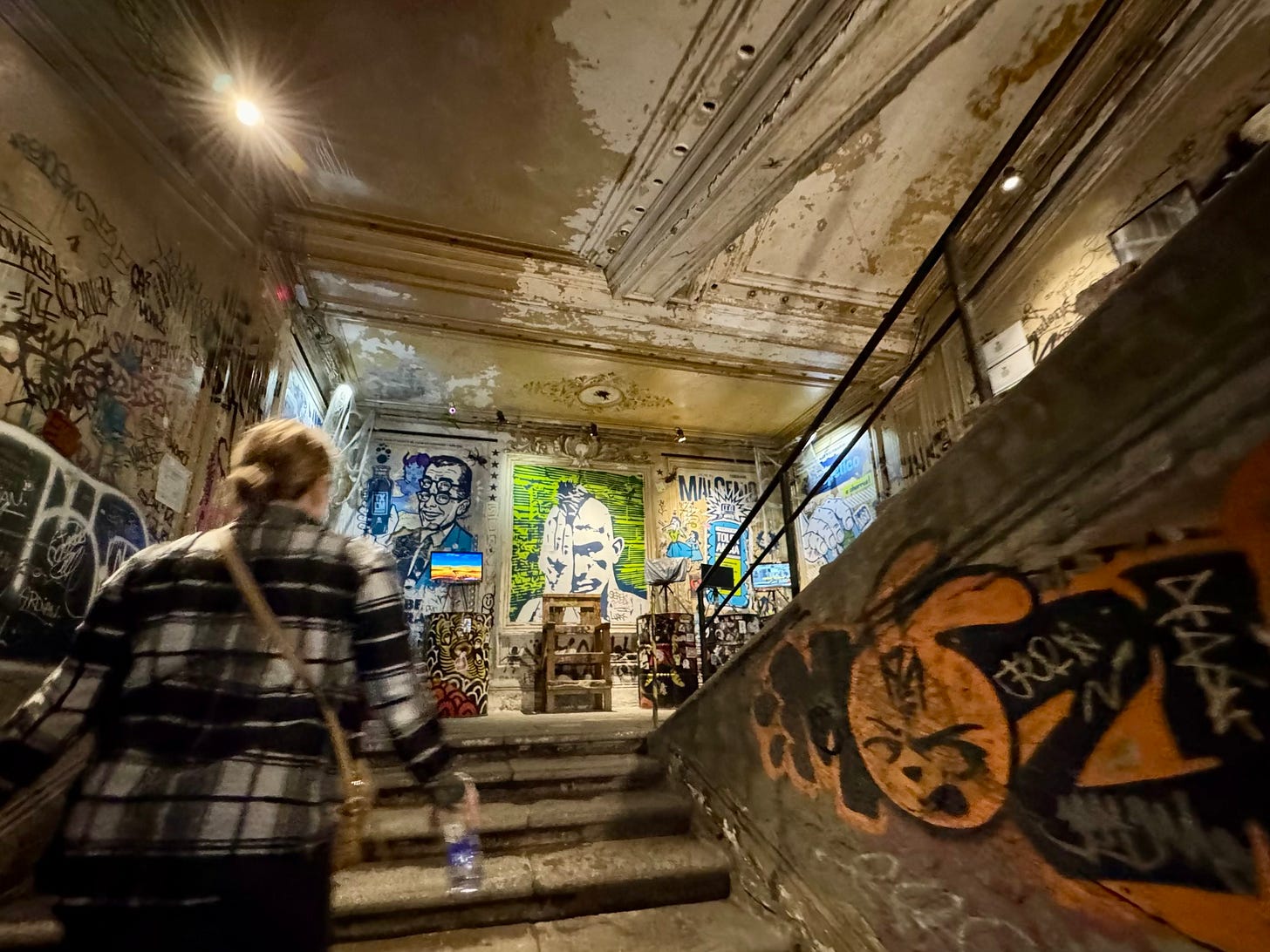


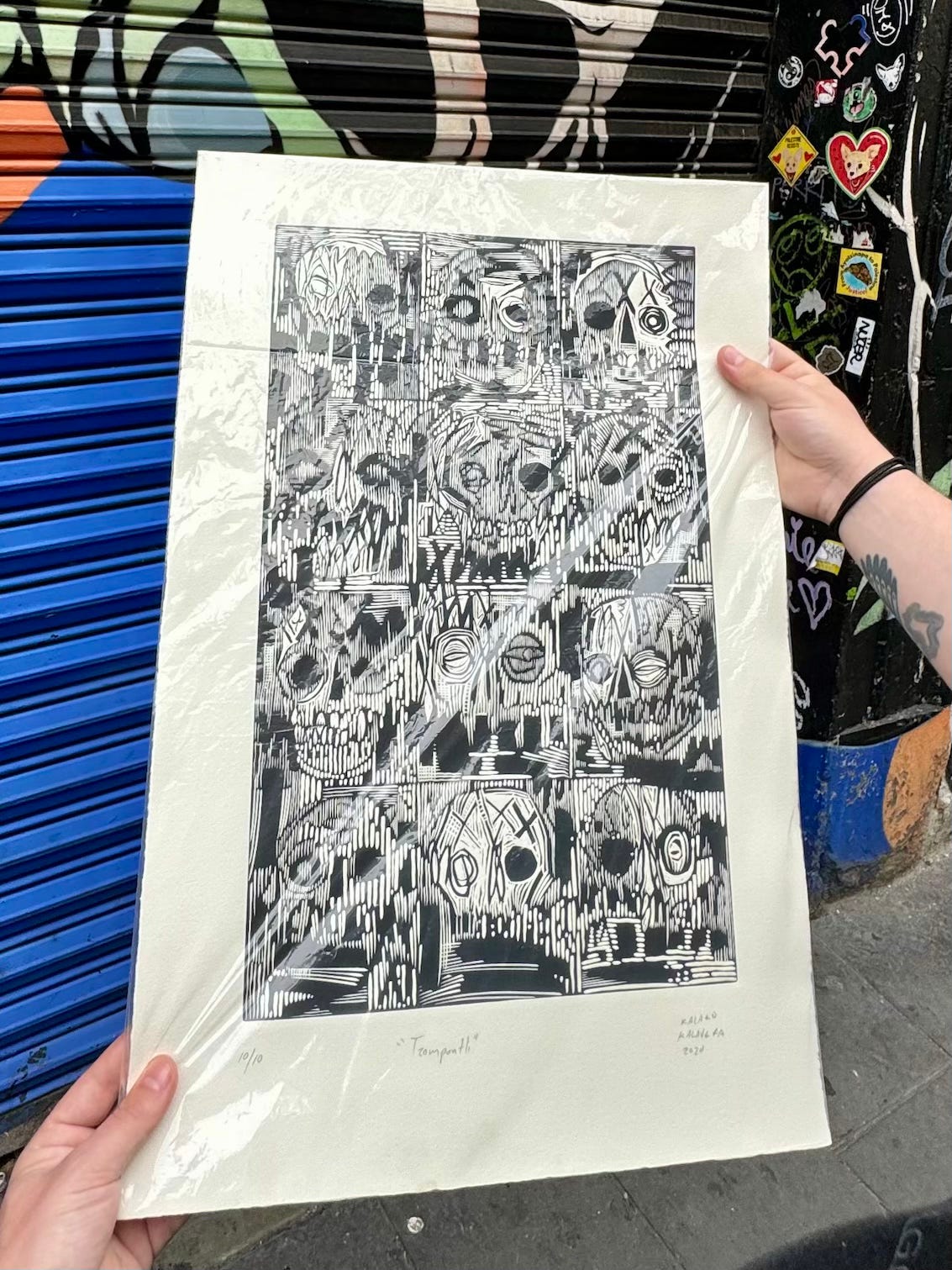

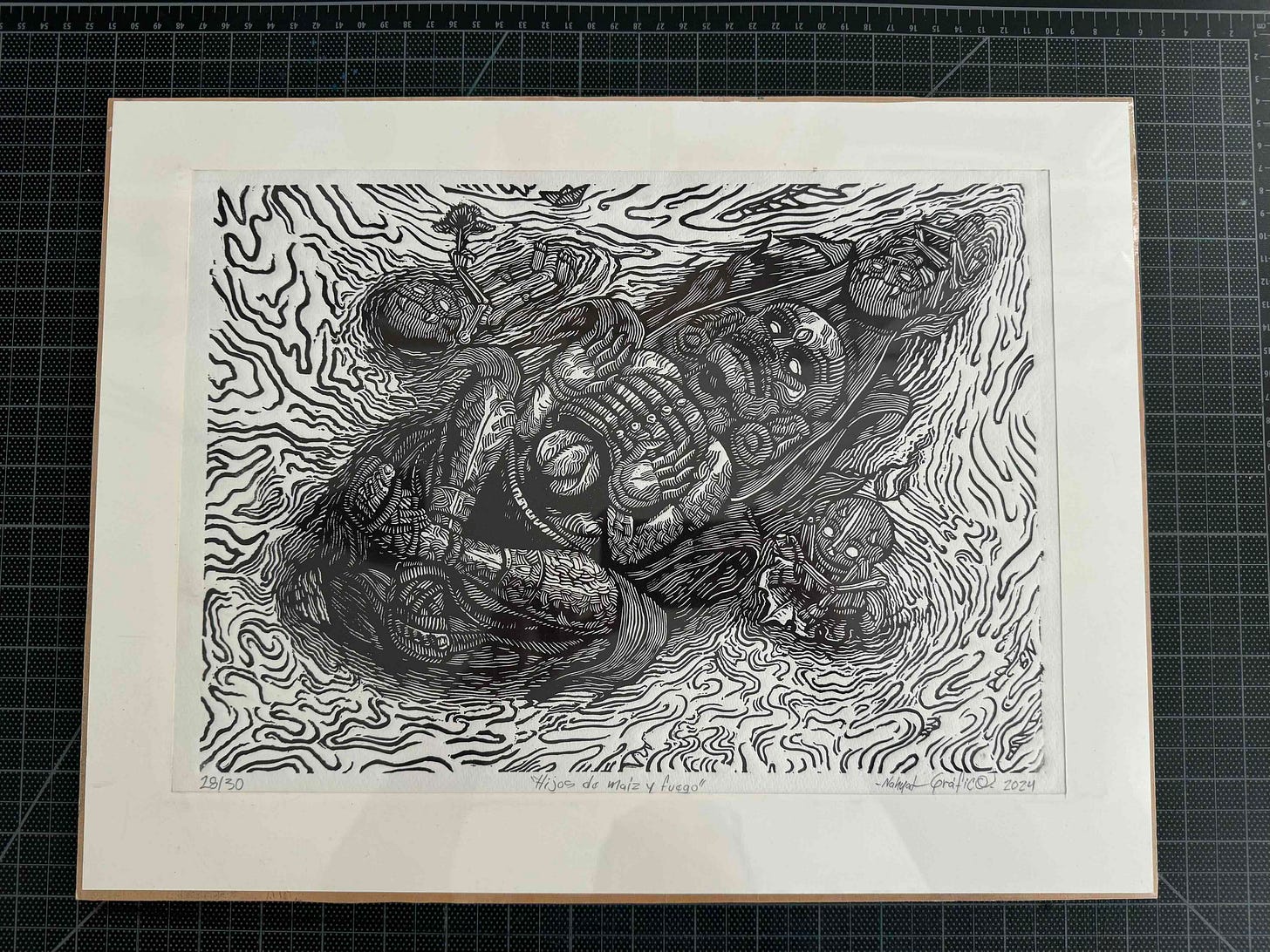
Gorgeous stuff! I love cool paper products. Worked for a printer once and you really get so accustomed to the side differences.